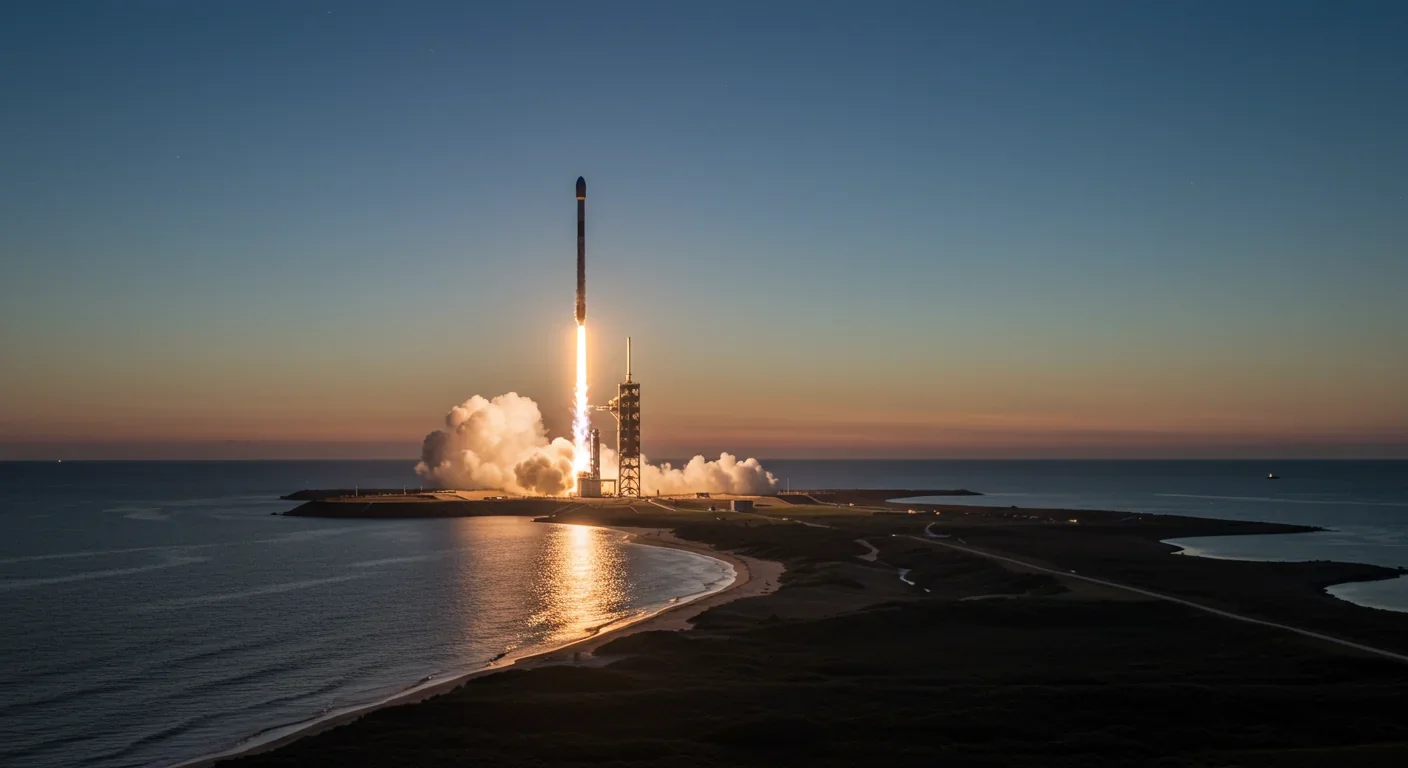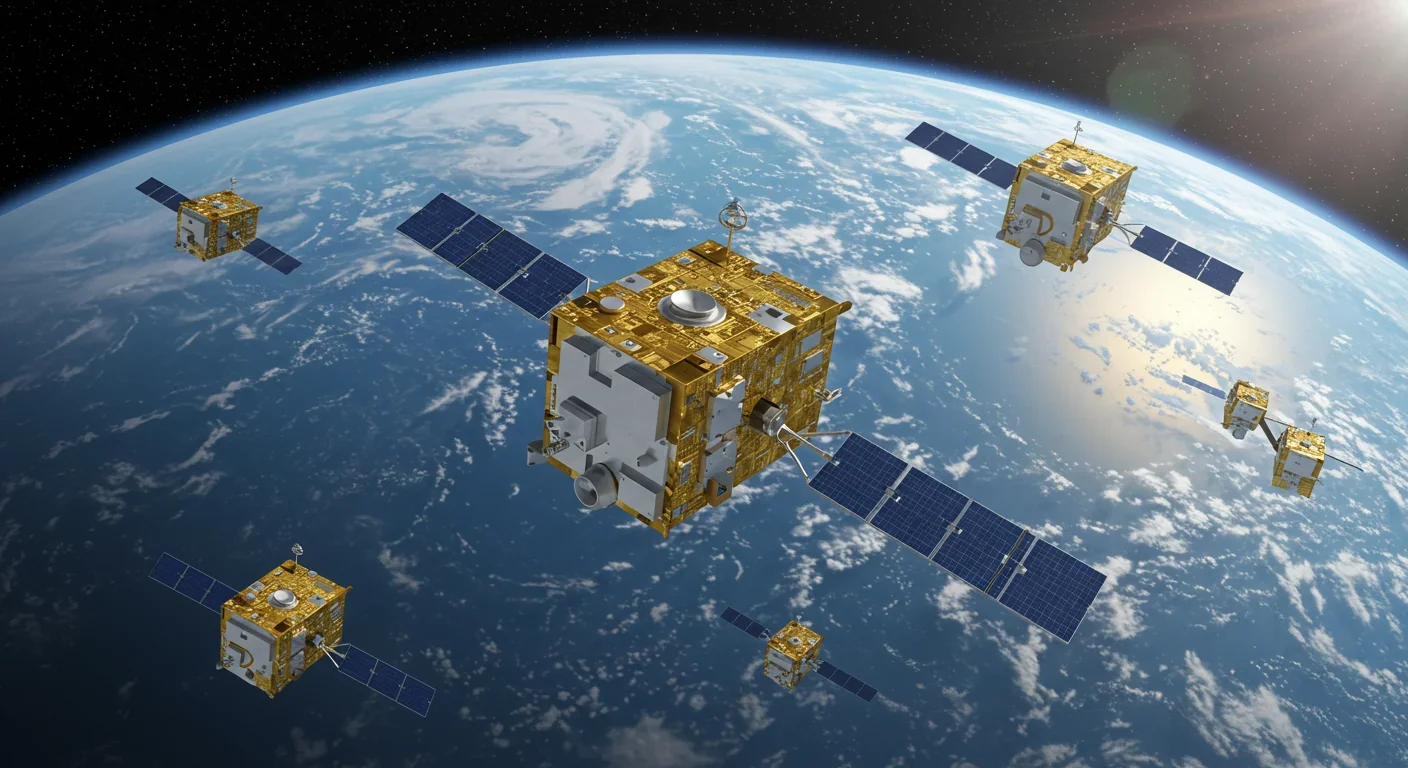Fusion Rockets Could Reach 10% Light Speed: The Breakthrough

TL;DR: Over 10,000 satellites now orbit Earth, with projections suggesting up to 100,000 by 2030. Mega-constellations like Starlink are driving this boom through dramatically reduced launch costs and miniaturization. However, orbital congestion threatens collision cascades, astronomical observations, and long-term space access sustainability.

By 2030, over 100,000 satellites could be orbiting Earth, a twentyfold increase from just a decade earlier. This astronomical surge transforms everything from rural internet access to global navigation systems, but it also raises a troubling question: are we filling the sky faster than we can manage it?
October 4, 1957 marked humanity's first step into orbital space. The Soviet Union launched Sputnik-1, a basketball-sized sphere weighing 83.6 kilograms, into low Earth orbit. Its radio beeps, transmitted back to Earth for three weeks, sparked what became known as the Sputnik crisis, galvanizing the United States into a space race that would redefine global politics and technology for generations.
For decades after Sputnik, satellite deployment remained a slow, expensive affair reserved for governments and the wealthiest corporations. By 2010, fewer than 1,000 active satellites circled our planet. These early satellites were typically large, expensive, and launched individually or in small groups. Each mission represented years of planning and hundreds of millions in investment.
But around 2015, something changed. The economics of space access began to shift dramatically, driven by reusable rockets, miniaturized electronics, and a new vision for what satellites could do. Companies like SpaceX pioneered reusable launch systems that slashed costs from tens of thousands of dollars per kilogram to under $3,000. Suddenly, space wasn't just for superpowers anymore.
Today, we're living through the most dramatic transformation in orbital infrastructure since Sputnik. As of 2025, approximately 10,000 active satellites orbit Earth, with SpaceX's Starlink constellation alone accounting for more than 6,800 of them. The United States operates over 6,800 satellites, China around 1,200, and the United Kingdom approximately 700.
What's driving this explosion? The answer is mega-constellations, networks of hundreds or thousands of small satellites working together to provide global services. Starlink, launched in 2019, aims to deliver high-speed internet to every corner of the planet. Amazon's Project Kuiper is deploying 3,236 satellites to compete in the same market. China is building its own constellation called Guowang with plans for 13,000 satellites.
These aren't your grandfather's satellites. Modern constellation satellites typically weigh between 200 and 300 kilograms, far smaller than traditional telecommunications satellites that can exceed 6,000 kilograms. They orbit at altitudes between 340 and 1,200 kilometers, much closer to Earth than the geostationary satellites at 35,786 kilometers that dominated previous decades.
The shift to low Earth orbit (LEO) brings significant advantages. Lower altitudes mean less signal delay, critical for internet applications. Smaller satellites cost less to build and launch. And if one fails, there are hundreds of backups maintaining service continuity.
The pace of launches has accelerated to match constellation ambitions. SpaceX now launches Starlink missions almost weekly, deploying 20 to 60 satellites per flight. In 2024 alone, SpaceX conducted over 130 orbital launches, more than the entire world combined just a decade earlier.
This isn't just an American phenomenon. China's launch frequency has tripled since 2020, with state-owned enterprises and private companies competing for market share. Europe, Japan, and India are expanding their launch capabilities to serve growing commercial demand. Even African nations are becoming significant players, leveraging satellite technology for development goals.
Rocket Lab, a smaller competitor to SpaceX, recently secured a 21-mission contract with Japanese company Synspective to launch synthetic aperture radar satellites. This single contract, the largest in Rocket Lab's history, illustrates how routine satellite deployment has become. Companies now purchase launches in bulk like ordering office supplies.
The small satellite launch market is projected to grow from $8.34 billion in 2024 to over $22 billion by 2033, according to industry research. Launch providers are racing to meet demand, with more than 50 companies worldwide competing for contracts.
Cost reduction has been the secret sauce enabling this satellite boom. In the 1990s, launching a single kilogram to orbit cost around $50,000 to $85,000. Today, SpaceX advertises prices under $3,000 per kilogram on its workhorse Falcon 9 rocket. When Starship becomes fully operational, Elon Musk claims costs could drop below $10 per kilogram, though experts remain skeptical of such extreme projections.
Still, the trend is clear. Reusable rockets have transformed the economics. SpaceX's Falcon 9 first stages have flown up to 23 times, spreading fixed development costs across dozens of missions. Competitors like Rocket Lab are developing their own reusable systems to stay competitive.
Satellite manufacturing has followed a similar cost curve. Mass production techniques borrowed from consumer electronics have driven prices down. A single Starlink satellite costs roughly $250,000 to build, a fraction of the $500 million price tag for traditional communications satellites.
These economics enable entirely new business models. Space Infrastructure as a Service is emerging as a sector, with companies offering hosted payloads, on-orbit computing, and data relay services. Customers no longer need to build, launch, and operate their own satellites. They simply rent capacity on someone else's constellation.

Success brings consequences. As orbital space becomes more accessible and affordable, it also becomes more congested. The risks fall into several categories, each more pressing as satellite numbers grow.
Collision Risk and Kessler Syndrome
The most immediate danger is physical collision. At orbital velocities of 7 to 8 kilometers per second, even a paint chip carries the kinetic energy of a bowling ball traveling at highway speeds. A collision between two satellites creates thousands of fragments, each capable of destroying other satellites in a cascading effect called Kessler Syndrome.
Named after NASA scientist Donald Kessler, who predicted this scenario in 1978, the syndrome describes a point where orbital debris density becomes so high that collisions create more debris faster than natural processes can clear it. Some orbits could become unusable for generations.
Are we close to this threshold? Experts debate the answer. The European Space Agency tracks over 130 million debris objects larger than 1 millimeter. Only about 36,500 objects larger than 10 centimeters can be tracked reliably, but these pose the greatest danger to operational satellites. Recent research suggests certain orbital shells, particularly between 700 and 1,000 kilometers altitude, are approaching critical density levels.
SpaceX reports performing thousands of collision avoidance maneuvers annually for its Starlink constellation. As more constellations launch, the number of close approaches will increase exponentially, not linearly. A constellation of 10,000 satellites faces 100 times more potential collision scenarios than a constellation of 1,000.
Astronomical Interference
Satellites don't just risk hitting each other. They also interfere with our view of the cosmos. Astronomers have raised alarms about mega-constellations creating artificial light pollution that degrades telescope observations.
A Starlink satellite crossing a telescope's field of view creates a bright streak, ruining long-exposure images essential for detecting faint galaxies, asteroids, or other celestial objects. With thousands of satellites in low Earth orbit, no part of the sky remains free from potential interference. The Vera Rubin Observatory in Chile, designed to survey the entire southern sky repeatedly, could lose up to 30% of its imaging time to satellite trails.
SpaceX has implemented mitigation measures, including darker satellite coatings and adjusting satellite orientation to reduce reflectivity. But these partial solutions don't eliminate the problem, and not all operators have been as responsive. As China, Russia, and other nations deploy their own mega-constellations, coordinating mitigation efforts across competing systems becomes increasingly difficult.
Orbital Debris and Cleanup Challenges
Every satellite eventually becomes debris. Even with functioning propulsion systems, satellites occasionally fail, leaving unpowered hulks drifting through valuable orbital space. The proliferation of small satellites exacerbates this problem because their shorter operational lifetimes mean more frequent replacements.
International guidelines recommend satellites deorbit within 25 years of mission completion, but compliance is voluntary and enforcement nonexistent. Many satellites fail before reaching end of life, unable to perform planned deorbit maneuvers. Low Earth orbit satellites naturally decay over years or decades due to atmospheric drag, but higher orbits can remain cluttered for centuries.
Several companies are developing debris removal technologies, from robotic arms to plasma propulsion systems that accelerate orbital decay. Japan's Tohoku University recently demonstrated a plasma-based system that could help clear debris more efficiently. But the economics remain challenging. Who pays to clean up someone else's defunct satellite? Should debris removal be treated as a public good, like lighthouses or air traffic control?
Private companies now dominate orbital space in ways unimaginable during the Cold War. SpaceX operates more satellites than all governments combined. Amazon is positioning Project Kuiper as a serious competitor, having already launched test satellites and secured launch contracts for hundreds more missions.
Traditional satellite operators, Intelsat, SES, and Eutelsat, still dominate geostationary communications markets, but their growth has stalled. The future belongs to constellations serving broadband internet, Earth observation, and specialized data services.
Planet Labs operates over 200 Earth observation satellites, capturing daily imagery of the entire planet at three-meter resolution. These satellites, each about the size of a shoebox, have democratized access to satellite imagery that once required multibillion-dollar government programs.
Military and intelligence satellites remain significant, though their exact numbers are classified. The U.S. Space Force operates hundreds of satellites for communications, navigation, reconnaissance, and missile warning. China and Russia are rapidly expanding their military space capabilities, blurring lines between civilian and military applications in ways that worry security analysts.

Satellite mass varies dramatically based on mission requirements. At the small end, CubeSats weigh as little as 1 kilogram. These standardized, cube-shaped satellites, originally developed for university research, have become workhorses for commercial applications ranging from agricultural monitoring to ship tracking.
Mid-sized satellites, including most constellation units, fall between 100 and 500 kilograms. Starlink satellites weigh approximately 260 kilograms each, balancing capability against launch costs. Each carries solar panels generating about 4.5 kilowatts, phased array antennas for communication, and ion thrusters for orbital adjustments.
At the large end, traditional geostationary satellites can exceed 6,000 kilograms. These massive spacecraft provide telecommunications, television broadcasting, and weather monitoring from fixed positions 35,786 kilometers above the equator. Their altitude gives each satellite coverage of roughly one-third of Earth's surface, but the distance introduces signal delays that make them unsuitable for applications like video conferencing or online gaming.
Scientific satellites represent another category entirely. NASA's James Webb Space Telescope, while not orbiting Earth, weighs 6,500 kilograms and required decades of development. Earth-orbiting research satellites like the Hubble Space Telescope or the International Space Station represent investments measured in billions of dollars, distinct from the commercial satellites flooding LEO today.
The satellite boom shows no signs of slowing. Industry projections suggest 60,000 to 100,000 satellites could be in orbit by 2030. China has approved plans for multiple mega-constellations totaling tens of thousands of satellites. The LEO satellite market is expected to reach $44.66 billion by 2032, up from $22.86 billion in 2024.
This growth will deliver real benefits. Rural communities gain access to high-speed internet. Developing nations leapfrog expensive terrestrial infrastructure. Real-time Earth observation enables better disaster response, agricultural management, and climate monitoring. Navigation systems become more accurate and resilient.
But realizing these benefits requires addressing the challenges head-on. International cooperation on debris mitigation, collision avoidance standards, and astronomical protection remains inadequate. The United Nations Committee on the Peaceful Uses of Outer Space provides a forum for dialogue, but its guidelines lack enforcement mechanisms.
Some experts advocate for stronger regulatory frameworks, perhaps including mandatory debris removal bonds or international fees on orbital launches to fund cleanup efforts. Others argue market forces will eventually price irresponsible behavior out of existence, if launch costs remain low enough and insurance premiums high enough for risky operations.
Technology will play a role too. Better tracking systems can monitor smaller debris. Autonomous collision avoidance reduces human error. Active debris removal demonstrates feasibility, even if economics remain challenging. Standardized satellite designs could facilitate end-of-life disposal or even on-orbit servicing and recycling.
From Sputnik's 83-kilogram sphere to constellations of thousands, satellites have become integral infrastructure for modern civilization. They enable technologies we take for granted: GPS navigation, weather forecasting, global communications, and streaming entertainment. The next decade will test whether we can scale this infrastructure sustainably or whether orbital congestion will impose hard limits on space access.
The satellite industry stands at an inflection point. Current trajectories suggest continued rapid growth, falling costs, and expanding capabilities. But physical constraints, collision risks, and astronomical interference represent real limits that require serious attention before crisis forces reactive measures.
Unlike Earth's surface, where we can clean up pollution gradually over decades, orbital space offers no such forgiveness. Objects remain in orbit for years, decades, or centuries depending on altitude. Decisions made today about constellation deployment, debris mitigation, and international coordination will shape the orbital environment for generations to come.
We've come a long way from that October evening in 1957 when Sputnik's beeps announced humanity's arrival in space. The challenge now is ensuring that the orbital highways we're building today remain passable for the innovations of tomorrow. Whether we rise to that challenge will determine not just the future of space access, but the continued functioning of technologies billions of people depend on every day.

Recent breakthroughs in fusion technology—including 351,000-gauss magnetic fields, AI-driven plasma diagnostics, and net energy gain at the National Ignition Facility—are transforming fusion propulsion from science fiction to engineering frontier. Scientists now have a realistic pathway to accelerate spacecraft to 10% of light speed, enabling a 43-year journey to Alpha Centauri. While challenges remain in miniaturization, neutron management, and sustained operation, the physics barriers have ...

Epigenetic clocks measure DNA methylation patterns to calculate biological age, which predicts disease risk up to 30 years before symptoms appear. Landmark studies show that accelerated epigenetic aging forecasts cardiovascular disease, diabetes, and neurodegeneration with remarkable accuracy. Lifestyle interventions—Mediterranean diet, structured exercise, quality sleep, stress management—can measurably reverse biological aging, reducing epigenetic age by 1-2 years within months. Commercial ...

Data centers consumed 415 terawatt-hours of electricity in 2024 and will nearly double that by 2030, driven by AI's insatiable energy appetite. Despite tech giants' renewable pledges, actual emissions are up to 662% higher than reported due to accounting loopholes. A digital pollution tax—similar to Europe's carbon border tariff—could finally force the industry to invest in efficiency technologies like liquid cooling, waste heat recovery, and time-matched renewable power, transforming volunta...

Humans are hardwired to see invisible agents—gods, ghosts, conspiracies—thanks to the Hyperactive Agency Detection Device (HADD), an evolutionary survival mechanism that favored false alarms over fatal misses. This cognitive bias, rooted in brain regions like the temporoparietal junction and medial prefrontal cortex, generates religious beliefs, animistic worldviews, and conspiracy theories across all cultures. Understanding HADD doesn't eliminate belief, but it helps us recognize when our pa...

The bombardier beetle has perfected a chemical defense system that human engineers are still trying to replicate: a two-chamber micro-combustion engine that mixes hydroquinone and hydrogen peroxide to create explosive 100°C sprays at up to 500 pulses per second, aimed with 270-degree precision. This tiny insect's biochemical marvel is inspiring revolutionary technologies in aerospace propulsion, pharmaceutical delivery, and fire suppression. By 2030, beetle-inspired systems could position sat...

The U.S. faces a catastrophic care worker shortage driven by poverty-level wages, overwhelming burnout, and systemic undervaluation. With 99% of nursing homes hiring and 9.7 million openings projected by 2034, the crisis threatens patient safety, family stability, and economic productivity. Evidence-based solutions—wage reforms, streamlined training, technology integration, and policy enforcement—exist and work, but require sustained political will and cultural recognition that caregiving is ...

Every major AI model was trained on copyrighted text scraped without permission, triggering billion-dollar lawsuits and forcing a reckoning between innovation and creator rights. The future depends on finding balance between transformative AI development and fair compensation for the people whose work fuels it.